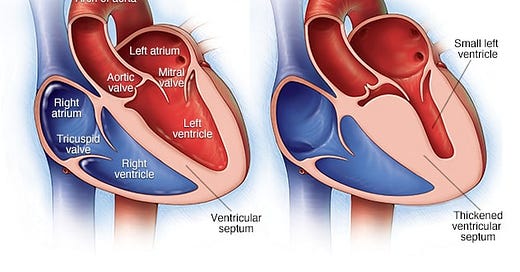February 28, 2024 is Hypertrophic Cardiomyopathy Awareness Day. As part of the effort to increase awareness, I wrote the following third person account of my experience with diagnosis and treatment to be shared with the Hypertrophic Cardiomyopathy Association. To learn more about HCM, please visit their website at 4HCM.org
Dawn’s Heart Story
Dawn Levitt grew up without any knowledge of heart disease in her family. Several relatives of both of her parents passed away in early middle age, but no one made a connection linking their deaths. Her family harbored a distrust of doctors and rarely sought medical care for themselves, but Dawn ended up at the doctor’s office or Emergency Room often due to severe asthma which left her winded and dizzy after physical exertion.
At the age of seven, after she passed out during gym class, her pediatrician detected a heart murmur and referred her to the larger children’s hospital in Detroit. The pediatric cardiologist in Detroit diagnosed her with Idiopathic Hypertrophic Subaortic Stenosis (IHSS). This diagnosis would later be known as Hypertrophic Cardiomyopathy. The doctor prescribed beta blockers and advised against physical exertion.
Dawn’s family journeyed to Detroit for annual exams until her teenage years when a cardiologist opened an office in their small, rural town. At sixteen, the new doctor delivered the devastating news that her heart condition was so severe she was unlikely to live past the age of thirty.
After high school, believing she didn’t have much time to live, she sought to cram as much living as she could into her remaining years, hurtling through her twenties at breakneck speed. As a minor, she received coverage through the state’s health insurance for impoverished children, but that ended when she turned eighteen. She went long stretches without health insurance or medical care. During this time, she attended the community college a few credits at a time and completed enough classes to find a decent job with good insurance just before she turned thirty.
Her heart symptoms continued to worsen, and she found a different cardiologist who added anti-arrythmia drugs to her beta-blocker regimen. On a visit to this doctor shortly before her 36th birthday, she mentioned an episode of nearly passing out while running to catch a flight, and he noted a weight gain of eight pounds since her last visit. “I think you will feel better if you lose weight,” he told her. Six weeks later, Dawn presented to the local Emergency Room in acute heart failure. Her sudden weight gain had been fluid retention. “I was in heart failure, but he diagnosed me as overweight.”
During this hospital stay, the cardiologist who managed her care during her teenage years happened to be the cardiologist on duty. He explained her heart failure was the natural progression of HCM. “There is nothing more we can do for you,” he announced.
Dawn refused to take “no” for an answer and researched HCM when she came home from the hospital. Search engines were not very robust in 2003, making information hard to find, but she learned about the Cleveland Clinic and managed to get an appointment with a cardiologist for the following week. They admitted her to the hospital immediately. While hospitalized in Cleveland, she met a world-renowned cardiologist who explained her HCM and laid out a path which included a pacemaker and ICD, with the potential for a heart transplant.
Dawn did have a pacemaker with ICD implanted, followed by her first heart transplant two years later in January 2006. She credits her determination to educate herself and advocate for a better solution as the key to her survival. “If I had known about the Hypertrophic Cardiomyopathy Association back then, it would have made my journey much easier. Now, I try to share the HCMA with everyone because you never know who needs their help.”
Dawn is currently living with her second heart transplant, received in October 2018. She is a freelance writer living in Michigan with her husband and two dogs. She is grateful that her two adult stepsons don’t carry her genes and won’t have inherited HCM. On a recent trip to Hawaii, she and her husband climbed to the top of Diamond Head, a journey she never could have made with her original heart.
.




